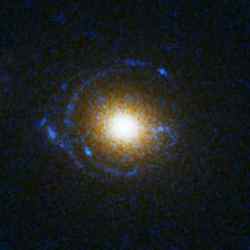Quantum Multiverse Theory
My theory begins by assuming the quantum multiverse theory; a theory in which the big bang was one of many (an infinitude?) resulting from quantum fluctuations of a singularity at the beginning of time.
Quantum physics tells us that particles the size that this singularity would have been have an existence that is probabilistic in nature; therefore our universe could be just one of a multitude of possible outcomes of these fluctuations.
According to the theory, all other possible universes were also created, but in alternate dimensions/universes; and by the anthropic principle we exist in this universe because it is the one that is conducive to life exactly as we know it.
Quantum Gravity and the Zero-Point-Field (ZPF)
My theory also assumes a quantum account of gravity. More specifically, it sees gravity as an effect of thermodynamic disequilibrium in the zero-point-field (ZPF) caused by the presence of material existence in a specific dimension/universe which draws its energy of existence from the ZPF.
The ZPF is kind of like the zero dimension; since it is just pure energy, it does not require time or space to exist in, it just is. Material existence is just organized energy at its core, this energy is constantly borrowed and returned to and from the ZPF in small quantities, or "quanta."
Quarks (the smallest known constituents of matter) flicker extremely fast in and out of existence as they borrow and return energy from the ZPF; each of these flickers introduces another instance of randomness in which the quark returns to existence in one of the possible points at which it can return according to the wave distribution of the probability of it being at any given point.
In most cases, it returns close to where it was before, but not always. In fact if you try to control where a particle is at any given time by closing it in a smaller and smaller box, it gets claustrophobic and will eventually appear outside the box by traveling through the ZPF; this quantum claustrophobia is characteristic of what is known as the Heisenberg uncertainty principle.
Because material existence "here" borrows energy from the ZPF it causes a vacuum of energy "there" (in the ZPF), causing surrounding energy to rush in to fill the gaps (as per second law of thermodynamics, entropy). It is the movement of this underlying energy of existence towards the center of the vacuum there (center of gravity here) that effectively distorts the probabilistic projections of each and every quark it rushes by, changing the distribution of material "here".
The projections of probability for each quark go...
The probability curves of the possible/probable locations available to each quark as it flickers back into existence after its brief exchanges of energy with the ZPF are slanted towards the direction of the gravity, causing each quark to tend to move towards the center of gravity. (This is the two-dimensional version .. more realistically it would be a change from a spherical distribution to a rain-drop-shaped one.)
So, for each quark's probabilistic wave distribution, the deck is stacked in favor of popping back into existence (after its exchange of energy with the ZPF) in a place that is closer to the center of gravity than where it popped out of existence before the exchange, creating the effect of motion through space-time.
Dark Matter
Dark matter, as we know it so far, is characterized by ambient gravity with not much else in observable phenomenon to be measured or studied. Around super-clusters of galaxies, this ambient gravity creates a gravitational lens which bends light around the cluster of galaxies, creating ring shaped images of galaxies "behind" the cluster (relative to the observer). These ring shaped images are known as Einstein rings since he was the first to theorize their existence.
Our universe happens to have a cosmological constant that allows matter to form in the way that it does. In the quantum multiverse theory, there would be numerous alternate universes in alternate dimensions with similar cosmological constants (and therefore matter) and ours is but a typical universe among them. If these universes are all pulling the energy necessary for their existence from the same ZPF, then we would expect to see the effects across all of the universes. Given a quantum account of gravity like the one above, this effect would be in the form of ambient gravity.
This gravity would permeate all the universes, and create a general trend to pull galaxies "towards one another" in respect to the ZPF. This would create large general areas of overlap of position (relative to the ZPF) of galaxies in the different universes. The large spheres of ambient gravity that are observed by the Hubble telescope could be representative of a normative distribution of galaxies in different dimensions being drawn to the same general areas of the ZPF; and as each galaxy gets closer: the centralization of the gravity increases, therefore increasing the trend to move towards the center of gravity.
"As far as I'm concerned, if something is so complicated that you can't explain it in 10 seconds, then it's probably not worth knowing anyway."
~Calvin and Hobbes by Bill Waterson

